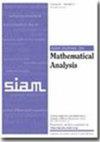Rigorous Derivation of Michaelis–Menten Kinetics in the Presence of Slow Diffusion
IF 1.9
2区 数学
Q1 MATHEMATICS, APPLIED
引用次数: 0
Abstract
SIAM Journal on Mathematical Analysis, Volume 56, Issue 5, Page 5995-6024, October 2024.Abstract. Reactions with enzymes are critical in biochemistry, where the enzymes act as a catalyst in the process. One of the most widely used mechanisms for modeling enzyme-catalyzed reactions is the Michaelis–Menten (MM) kinetics. On the ODE level, i.e., when concentrations are only time-dependent, this kinetics can be rigorously derived from mass action law using quasi-steady-state approximation. This issue in the PDE setting, for instance, when molecular diffusion is taken into account, is considerably more challenging, and only formal derivations have been established. In this paper, we prove this derivation rigorously and obtain MM kinetics in the presence of slow spatial diffusion. In particular, we show in this case that, in general, the reduced problem is a cross-diffusion-reaction system. Our proof is based on an improved duality method, heat regularization, and a suitable modified energy function. To the best of our knowledge, this work provides the first rigorous derivation of MM kinetics from mass action kinetics in the PDE setting.
严格推导存在慢扩散的迈克尔斯-门顿动力学
SIAM 数学分析期刊》,第 56 卷,第 5 期,第 5995-6024 页,2024 年 10 月。 摘要与酶的反应在生物化学中至关重要,酶在反应过程中起着催化剂的作用。Michaelis-Menten (MM) 动力学是模拟酶催化反应最广泛使用的机制之一。在 ODE 层面上,即当浓度仅与时间相关时,这种动力学可以通过准稳态近似从质量作用定律中严格推导出来。而在 PDE 环境中,例如考虑到分子扩散时,这个问题的难度要大得多,目前只建立了正式的推导。在本文中,我们严格证明了这一推导,并得到了存在缓慢空间扩散时的 MM 动力学。特别是,我们证明了在这种情况下,还原问题一般是一个交叉扩散-反应系统。我们的证明基于改进的对偶方法、热正则化和合适的修正能量函数。据我们所知,这项研究首次在 PDE 环境下从质量作用动力学严格推导出 MM 动力学。
本文章由计算机程序翻译,如有差异,请以英文原文为准。
求助全文
约1分钟内获得全文
求助全文
来源期刊
CiteScore
3.30
自引率
5.00%
发文量
175
审稿时长
12 months
期刊介绍:
SIAM Journal on Mathematical Analysis (SIMA) features research articles of the highest quality employing innovative analytical techniques to treat problems in the natural sciences. Every paper has content that is primarily analytical and that employs mathematical methods in such areas as partial differential equations, the calculus of variations, functional analysis, approximation theory, harmonic or wavelet analysis, or dynamical systems. Additionally, every paper relates to a model for natural phenomena in such areas as fluid mechanics, materials science, quantum mechanics, biology, mathematical physics, or to the computational analysis of such phenomena.
Submission of a manuscript to a SIAM journal is representation by the author that the manuscript has not been published or submitted simultaneously for publication elsewhere.
Typical papers for SIMA do not exceed 35 journal pages. Substantial deviations from this page limit require that the referees, editor, and editor-in-chief be convinced that the increased length is both required by the subject matter and justified by the quality of the paper.

 求助内容:
求助内容: 应助结果提醒方式:
应助结果提醒方式:


